
Female - SEM image
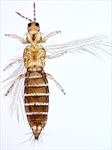
Dark form
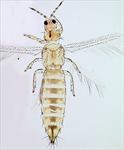
Common pest form
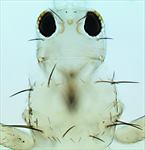
Head & pronotum

Antenna
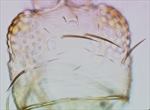
Head
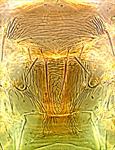
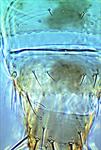
Tergites VII-IX
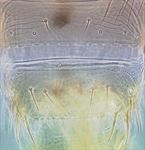
Tergites VII-VIII
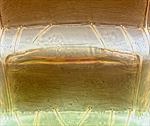
Female sternite VII

Fore wing
Both sexes fully winged. Body and legs variable in color; wild populations in California occurring as three distinct morphs (brown, yellow, & intermediate), but the widespread pest strain is usually mainly yellow with a brown patch on each tergite; antennal segments III–V yellow but apices variably brown; fore wing pale with dark setae. Antennae 8-segmented, III & IV each with a forked sense cone, VIII longer than VII. Head wider than long; three pairs of ocellar setae present, pair III longer than distance between external margins of hind ocelli, arising on anterior margins of triangle; postocular setae pair I present, pair IV longer than distance between hind ocelli. Pronotum with 5 pairs of major setae; anteromarginal setae slightly shorter than anteroangulars, one pair of minor setae present medially between posteromarginal submedian setae. Metanotum with 2 pairs of setae at anterior margin, campaniform sensilla usually present. Fore wing with 2 complete rows of veinal setae. Abdominal tergites V–VIII with paired ctenidia, these sometimes weakly developed on IV, on VIII anterolateral of spiracle; posteromarginal comb on VIII complete, with short slender microtrichia arising from triangular bases. Sternites III–VII without discal setae.
Male smaller and paler than female; tergite VIII with no posteromarginal comb; tergite IX posterolateral setae stout in larger males; sternites III–VII with transverse pore plate.
This species is very similar to F. intonsa, but has the postocular setae considerably longer, and usually (but not always!) has campaniform sensilla on the metanotum. In California, females of wild populations commonly occur in three different color morphs, dark, light and intermediate (Bryan & Smith, 1956). The dark forms are particularly common in montane areas. In contrast, populations associated with crops usually involve just the intermediate form (only teneral individuals being much paler), in which the abdomen is largely yellow with a dark patch medially on each tergite. Rugman-Jones et al. (2010) indicated that two species exist within populations of occidentalis , but these can be distinguished only by the use of molecular data, and biological differences between the molecular segregates have not been demonstrated. There are almost 240 species listed in the genus Frankliniella, with up to 130 further names placed into synonymy (Nakahara, 1997). This high rate of synonymy is due to the failure to recognize that many species are variable in size and color.
Breeding in flowers and on leaves, and recorded from a very wide range of plant species. The Western Flower Thrips is a vector of several tospoviruses (TSWV, TCSV, INSV, GRSV), and causes extensive damage to many crops worldwide, both through feeding damage particularly in young buds, and through virus vectoring.
Originally from western USA, but now almost worldwide, particularly in temperate areas (Kirk & Terry, 2004), but rare in wet tropical areas.
THRIPIDAE - THRIPINAE
Frankliniella occidentalis (Pergande)
Euthrips occidentalis Pergande, 1895: 392
Euthrips tritici var. californicus Moulton, 1911: 16
Euthrips helianthi Moulton, 1911: 40
Frankliniella tritici var. moultoni Hood, 1914: 38
Frankliniella nubila Treherne, 1924: 84
Frankliniella claripennis Morgan, 1925: 142
Frankliniella canadensis Morgan, 1925: 143
Frankliniella trehernei Morgan, 1925: 144
Frankliniella tritici maculata Priesner, 1925: 15
Frankliniella occidentalis f. brunnescens Priesner,1932: 182
Frankliniella occidentalis f. dubia Priesner, 1932: 182
Frankliniella venusta Moulton, 1936: 172
Frankliniella conspicua Moulton, 1936: 173
Frankliniella chrysanthemi Kurosawa, 1941: 173
Frankliniella dahliae Moulton, 1948: 97
Frankliniella dianthi Moulton, 1948: 98
Frankliniella syringae Moulton, 1948: 98
Frankliniella umbrosa Moulton, 1948: 105
Bryan DE & Smith RF (1956) The Frankliniella occidentalis (Pergande) complex in California (Thysanoptera: Thripidae). University of California Publications in Entomology 10: 359–410.
Kirk WDJ and Terry LI (2003) The spread of the western flower thrips Frankliniella occidentalis (Pergande). Agricultural and Forest Entomology 5 (4): 301–310.
Mound LA & Marullo R (1996) The Thrips of Central and South America: An Introduction. Memoirs on Entomology, International 6: 1–488.
Nakahara S (1997) Annotated list of the Frankliniella species of the world (Thysanoptera: Thripidae). Contributions on Entomology, International 2 (4): 355–389.
Rugman-Jones PF, Hoddle MS & Stouthamer R (2010) Nuclear-mitochondrial bar coding exposes the global pest western flower thrips (Thysanoptera: Thripidae) as two sympatric cryptic species in its native California. Journal of Economic Entomology 102: 877–886.